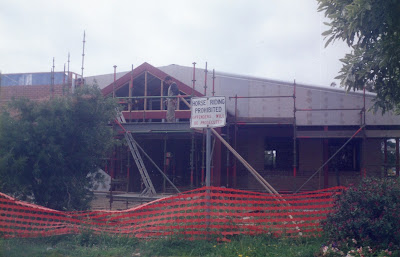Part of the Eumemmerring / Lyndhurst Parish Plan that shows the Dandenong Pound at the top right. The plan is dated January 14, 1859. You can see a better copy at the State Library of Victoria http://handle.slv.vic.gov.au/10381/150137
To give you some perspective - the land under the Pound was owned by Isaac Edey (lot 34). Edeys Run in modern day Hampton Park is around where the Edey homestead was located.
The Dandenong Pound
was officially established November 20, 1849 and the name was changed to the
Cranbourne Pound in July 1868. This pound was closed in January 1887 and
relocated.
Pounds played a larger role in the life of people in the early days than they do now - the Victorian Government Gazette has pages and pages of notices of impoundings of animals - stock was valuable and fences were poor. In some areas, as we have seen hawthorn hedges were used as fences or post and rail fences or wire fences. These fences were not as effective in holding cattle in as barbed wire fences, but it wasn't until November 1874 that Joseph Glidden took out the first patent for barbed wire in the USA. So it was more likely that livestock would go wandering and be impounded by the Pound Keeper, who could charge a fine for allowing the animals to stray and a daily 'sustenance' fee for feeding the animal. As a matter of interest the Kansas Barbed Wire Museum has a history of barbed wire on their website, you can read it here. The first advertisements in Australian newspapers for 'American barbed fencing wire' (that I could find) were in 1879.
It appears that Pound Road takes the most direct line across the old Cranbourne Shire to the pound from the eastern side of the Shire. The kinks in the road maybe due to influential landowners who refused to allow a road through their property. If you look at this map at the State Library of Victoria (below or click here) then you can see that starts at Tooradin Station Road/Ballarto Road and then is almost a direct line to Hampton Park, apart from the diversion around The Springs property, owned by Sir William Clarke, who would be as influential a land owner as you could find anywhere
East of Tooradin where Koo Wee Rup, Monomeith, Yannathan etc are was part of the Koo Wee Rup Swamp and until major drainage works commenced in 1889 was fairly uninhabited. There were early settlements down around Lang Lang but before the Swamp was drained and the roads improved it would have been common to travel by boat to Tooradin and then by road and then head to the Pound and Dandenong by either what became the South Gippsland Highway or north from Tooradin to Pound Road.
Establishment of the Pound
November 28, 1849
Change of name to Cranbourne Shire Pound
Victoria Government Gazette July 24, 1868
Relocation of the Pound from the original location
Victoria Government Gazette January 28, 1887
The earliest barbed wire advertisements I can find are from 1879.
The Australasian March 15, 1879
It appears that Pound Road takes the most direct line across the old Cranbourne Shire to the pound from the eastern side of the Shire. The kinks in the road maybe due to influential landowners who refused to allow a road through their property. If you look at this map at the State Library of Victoria (below or click here) then you can see that starts at Tooradin Station Road/Ballarto Road and then is almost a direct line to Hampton Park, apart from the diversion around The Springs property, owned by Sir William Clarke, who would be as influential a land owner as you could find anywhere
East of Tooradin where Koo Wee Rup, Monomeith, Yannathan etc are was part of the Koo Wee Rup Swamp and until major drainage works commenced in 1889 was fairly uninhabited. There were early settlements down around Lang Lang but before the Swamp was drained and the roads improved it would have been common to travel by boat to Tooradin and then by road and then head to the Pound and Dandenong by either what became the South Gippsland Highway or north from Tooradin to Pound Road.
Click on the map to enlarge or look at it on the State Library website, here. You can see where it starts and finishes (the red stars) and the kink around The Springs property (circled in red)
Map: Cranbourne prepared by Australian Section, Imperial General Staff.
Great Britain. War Office. General Staff. Australian Section, 1924.
Footnotes
(1) The surname is actually Garnar - I have written about them in my Diamond Hill post, here.
(2) Gunson, Niel The Good Country: Cranbourne Shire (Cheshire, 1968) p. 212.































